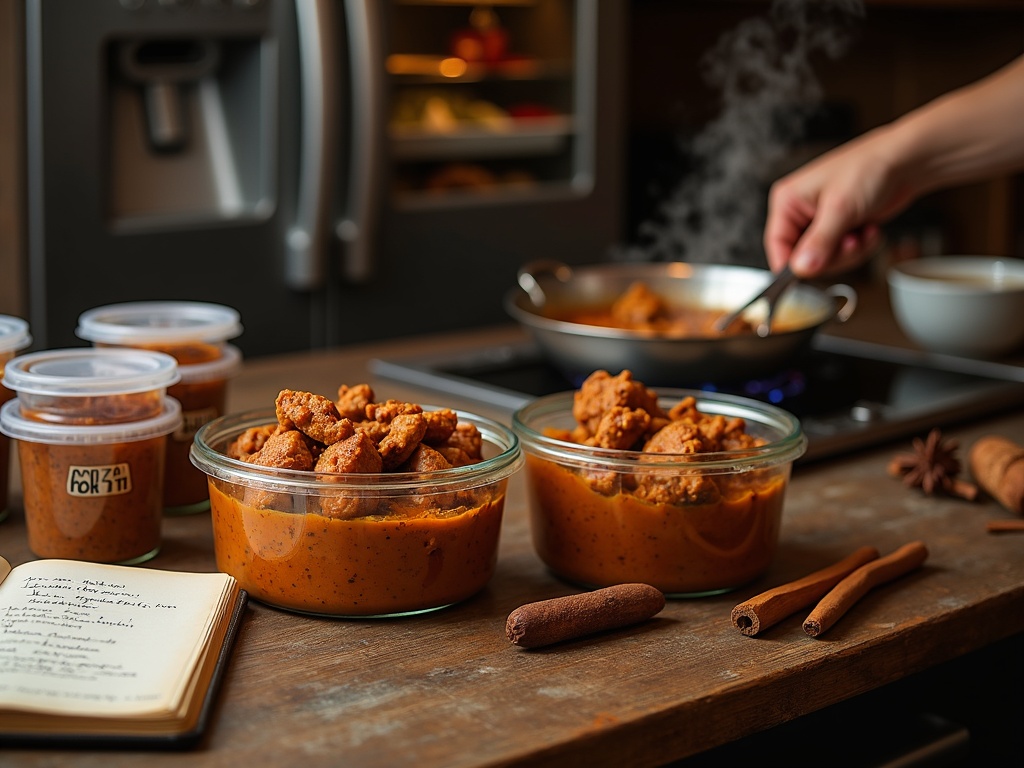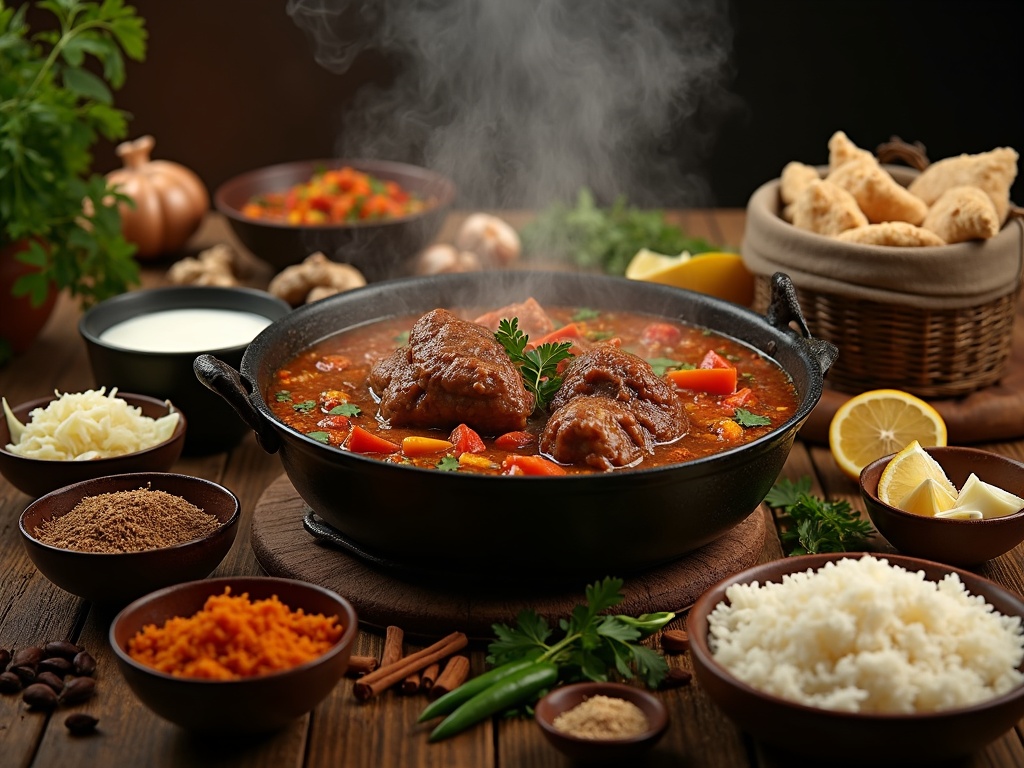Gosht: A Culinary Staple in South Asian Cuisine
Gosht serves as a cornerstone of South Asian cuisine, primarily referring to meat dishes crafted with goat or lamb. These creations represent authentic, flavor-packed meat preparations from the subcontinent.
Find In This Article
Key Takeaways
- Goat meat is traditionally preferred in authentic gosht preparations, though lamb serves as a common alternative. Both are typically cooked on the bone for maximum flavor development.
- Proper marination using yogurt and spices is essential. Ideally, the meat should be marinated for 4+ hours or overnight to tenderize and infuse it with complex flavors.
- Patience is key during cooking. Use low-to-medium heat, with simmering times ranging from 45 minutes to 2 hours to achieve optimal tenderness.
- Fresh spices such as garam masala, turmeric, cumin, and coriander form the base of flavor. These should be toasted and freshly ground for the best impact.
- Traditional accompaniments include naan bread or basmati rice. Gosht is often served with cooling raita, fresh herbs, and pickled vegetables for a complete meal experience.
For more in-depth exploration of gosht dishes and their variations, visit culinary resources or explore authentic South Asian recipes from trusted sources such as Saveur’s Mughal-Style Goat Curry.
What Is Gosht In Indian Cuisine?
Gosht is a fundamental term in South Asian cooking that refers primarily to meat dishes, particularly those made with goat or lamb. I’ve found that while many Westerners might be familiar with chicken-based curries like butter chicken in Indian cuisine, gosht dishes represent some of the most authentic and flavorful meat preparations from the subcontinent.
Origin and Cultural Significance
The word “gosht” itself comes from Persian and simply means “meat” in several South Asian languages including Urdu, Hindi, and Punjabi. In traditional South Asian households, gosht has long held a special place at the dining table. It’s often featured in celebratory meals and festive occasions, though it’s also enjoyed in everyday cooking across India and Pakistan.
Goat meat is typically preferred in authentic gosht preparations, especially in rural areas and traditional cooking. It’s valued for its distinct flavor and relatively lean profile compared to other meats. Lamb serves as a common alternative, particularly in restaurants and in regions where goat meat isn’t readily available. In Western adaptations of these dishes, you might occasionally see beef or mutton substituted, though purists would argue this changes the fundamental character of the dish.
When preparing gosht dishes, the meat is often cooked on the bone where possible, as this adds depth and richness to the final dish. The cooking process generally involves:
- Marinating the meat with yogurt and spices to tenderize it
- Slow-cooking to develop complex flavors and tender texture
- Using whole spices like cardamom, cinnamon, and cloves for aromatic depth
- Incorporating regional variations through specific spice blends
Popular gosht preparations include:
- Rogan Josh from Kashmir
- Gosht Biryani where meat is layered with fragrant rice
- Gosht Korma which, unlike Irish stew, features meat braised in a rich, yogurt-based gravy
These dishes showcase how versatile gosht can be while maintaining its status as a protein-rich centerpiece in South Asian gastronomy.
Selecting The Right Meat For Gosht
The foundation of an exceptional gosht dish starts with selecting the perfect meat. I’ve discovered through years of cooking that the quality and type of meat dramatically impacts the final flavor profile of this classic dish. When shopping for meat to prepare a delicious Indian-style gosht curry, there are several key factors to consider.
Prime Meat Options and Cuts
Fresh goat or lamb meat is traditionally preferred for authentic gosht preparations. Both meats deliver that distinctive rich flavor that’s characteristic of classic gosht dishes. While goat meat (also called mutton in some regions) offers a slightly gamier profile, lamb provides a milder, more delicate taste that many find more approachable. I’ve found that either choice works beautifully, but lamb is often easier to source in many Western markets.
When examining the meat, I always look for cuts with some fat marbling throughout. This natural fat content is crucial as it slowly melts during the cooking process, creating that velvety texture and depth of flavor that makes gosht so satisfying. Completely lean cuts tend to yield drier results, so don’t shy away from a modest amount of fat.
Bone-in pieces are particularly valuable in gosht preparation. The bones infuse the curry with an incredible richness that simply can’t be achieved otherwise. I’ve noticed that bone-in lamb pieces release collagen during slow cooking, which transforms the sauce into something truly special with a silky mouthfeel.
For consistently excellent results, I recommend focusing on these specific cuts:
- Shoulder cuts: Perfect for gosht due to their ideal fat-to-meat ratio and excellent flavor
- Leg portions: Particularly the upper parts that contain more connective tissue
- Neck pieces: These deliver exceptional flavor though require longer cooking
- Shanks: When cut into smaller sections, they provide wonderful texture contrast
The shoulder is my personal favorite for its balance of tenderness and flavor. It breaks down beautifully during the long, slow cooking that gosht typically requires. For a more special occasion or when serving guests, I might use leg cuts which offer slightly more tenderness.
When purchasing your meat, freshness indicators include a bright color (pinkish-red for lamb, darker red for goat) and minimal odor. I always examine the packaging date when buying from supermarkets or develop a relationship with a trusted butcher who can guide me to the freshest options for hearty meat stews and curries.
If using frozen meat, proper thawing is essential—always thaw slowly in the refrigerator rather than at room temperature to maintain quality and food safety. I’ve learned that meat at room temperature before cooking also helps achieve more even results in the finished dish.
The cut size matters as well—I aim for 1-2 inch pieces that are neither too large (which makes them difficult to eat) nor too small (which can lead to overcooking). Consistency in size ensures uniform cooking throughout the dish.
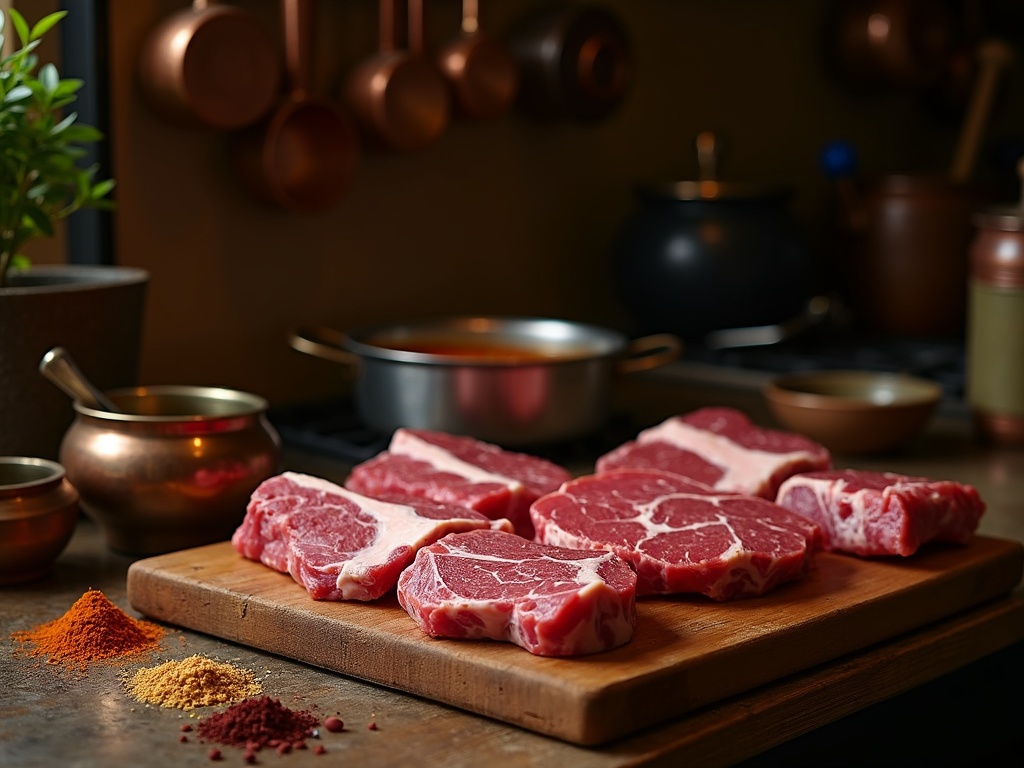
Essential Spices And Ingredients
Creating an authentic gosht (meat) dish requires a careful selection of spices and ingredients that bring out the rich, deep flavors characteristic of this classic preparation. I’ve found that having the right ingredients on hand makes all the difference between an ordinary meat dish and an extraordinary one.
Core Spice Selection
The foundation of any good gosht recipe starts with the perfect blend of spices. Garam masala, a warming spice mix typically containing cinnamon, cardamom, cloves, and other aromatics, adds depth and complexity to the meat. I always recommend adding it toward the end of cooking to preserve its aromatic qualities.
Turmeric powder contributes both color and earthy notes, while red chili powder determines the heat level of your dish. Don’t confuse Indian red chili powder with the American chili powder blend – they’re completely different products!
Coriander and cumin are essential for authentic flavor. Coriander powder lends a citrusy, slightly sweet note, while cumin seeds (either whole or ground) add warmth and earthiness to the dish. I toast cumin seeds in hot oil at the beginning of cooking for the most intense flavor release.
The fresh elements are just as important as the dry spices:
- Fresh garlic and ginger, preferably made into a paste, form the aromatic base
- Onions, finely chopped or blended, create the gravy’s foundation
- Tomatoes add tanginess and body to the sauce
- Yogurt tenderizes the meat during marination and adds creaminess to the final dish
For cooking fat, I alternate between regular cooking oil and ghee for authentic flavor depending on the specific regional variation I’m creating. Ghee imparts a nutty richness that’s particularly wonderful in gosht preparations from Northern India.
When preparing a gosht dish with lamb, these ingredients work together to tenderize the meat and create layers of flavor that develop during the slow cooking process. The yogurt marination is particularly important – I let the meat sit for at least two hours, though overnight produces even better results.
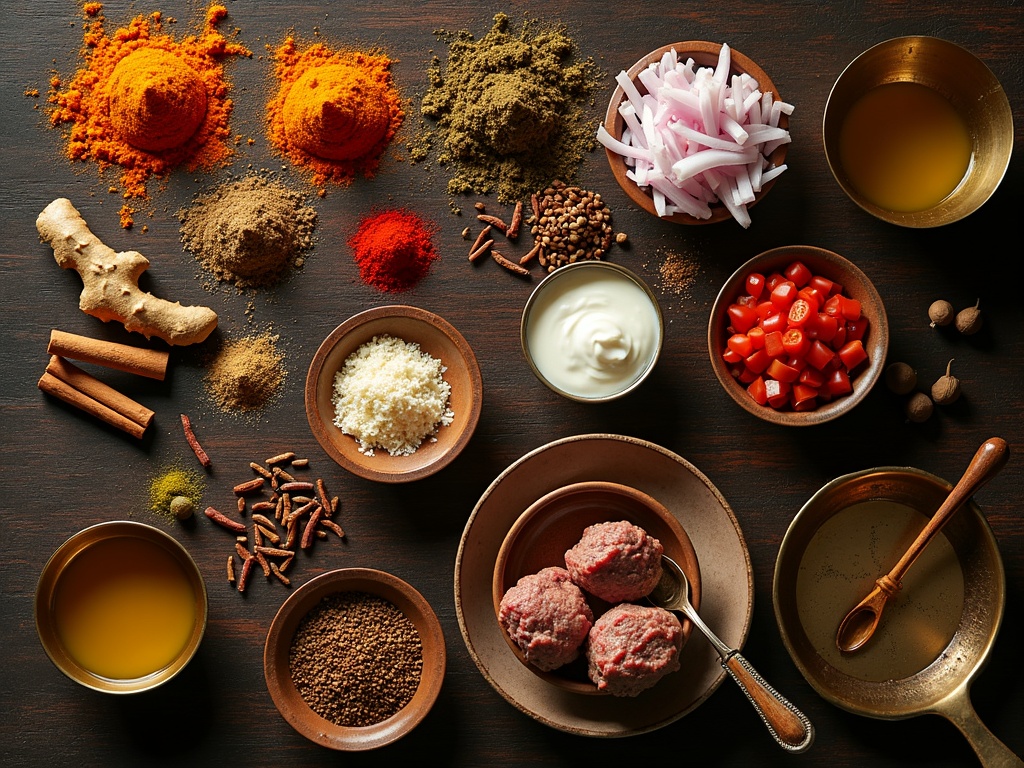
Preparing The Perfect Gosht
Gosht, a delicious meat dish with roots in South Asian cuisine, requires patient preparation and careful attention to technique. I’ve found that creating this aromatic and tender dish comes down to several key steps that, when followed properly, result in a meal that’s truly memorable. Let’s break down the process to help you achieve gosht perfection in your own kitchen.
The Art of Marination and Preparation
Marination is the foundation of any outstanding gosht dish. I typically start by combining plain yogurt with a blend of aromatic spices. The yogurt acts as both a tenderizer and flavor carrier, breaking down the tough fibers in the meat while infusing it with the complex spice profile.
For the best results, I recommend:
- Using full-fat yogurt rather than low-fat versions as it creates a richer base
- Incorporating freshly ground spices like cumin, coriander, turmeric, and garam masala
- Adding minced ginger and garlic for depth of flavor
- Allowing the meat to marinate for a minimum of 4 hours (overnight is even better)
After marination, the next crucial step involves properly browning onions until they reach a golden hue. This step shouldn’t be rushed – properly caramelized onions form the flavor foundation of your authentic Indian meat dish. The natural sugars in the onions create depth and complexity that elevates the entire dish.
The cooking process begins by heating oil or ghee in a heavy-bottomed pot before adding the marinated meat. I’ve learned that cooking the meat on medium heat is essential – too high, and the outside burns before the inside cooks; too low, and the meat becomes tough from extended cooking times.
Perfecting the Simmer and Finishing Touches
Patience is key during the simmering phase. After the initial cooking, I reduce the heat and let the meat simmer slowly until it reaches fork-tender perfection. This gradual cooking allows the spices to fully penetrate the meat while maintaining its moisture and texture. Depending on the cut of meat used, this can take anywhere from 45 minutes to 2 hours.
Once the meat has reached optimal tenderness, it’s time to create the gravy. I typically add tomatoes, whether fresh or pureed, along with additional spices that provide richness and complexity. For a more luxurious traditional flavor profile, I sometimes incorporate a splash of cream or a spoonful of cashew paste toward the end.
The final touch involves garnishing with freshly chopped cilantro just before serving. This isn’t merely decorative – the fresh herbs provide a bright, aromatic contrast to the rich, developed flavors of the slow-cooked dish. I find that adding a squeeze of lemon juice at this stage also helps to balance the richness with a subtle acidity.
Temperature control remains crucial throughout the entire cooking process. I’ve found that many home cooks make the mistake of cooking gosht at too high a temperature, which can lead to tough, dry meat. The secret truly lies in giving the dish time to develop its flavors gradually over low to medium heat.
When served with freshly made naan bread or fragrant well-prepared rice, gosht makes for a stunning centerpiece to any meal. The tender meat, combined with a rich, complex gravy, creates an experience that’s both satisfying and memorable. It’s worth investing the time to follow each step with care.
Common Mistakes To Watch For
When preparing gosht dishes, I’ve noticed several common errors that can make the difference between a mediocre meal and an exceptional one. These pitfalls are easy to avoid once you know what to look for.
Undermining the Foundation
Rushing the cooking process is perhaps the most prevalent mistake. Gosht dishes, whether it’s the rich butter chicken with tender meat or a hearty lamb curry, require patience. The meat needs time to become tender and absorb the complex flavors of the spices. I’ve found that at least 45-60 minutes of slow simmering is necessary for the meat fibers to break down properly.
Marination is another crucial step that’s often cut short. Many home cooks marinate gosht for just 30 minutes when overnight marination (or at minimum 4-6 hours) allows the meat to truly absorb the flavors. The yogurt and spices in the marinade don’t just add flavor—they also help tenderize the meat through enzymatic action.
Technical Missteps
Cooking on high heat is a guaranteed way to ruin your gosht. High temperatures cause the meat to toughen and the sauce to reduce too quickly, resulting in dry, chewy meat. Instead, I recommend maintaining a gentle simmer throughout the cooking process.
Many cooks also make the mistake of skipping the browning step. Taking the time to brown the meat before adding liquid ingredients creates a flavor foundation through the Maillard reaction. This simple step adds depth and complexity to the final dish, especially in preparations like traditional biryani where each element matters.
Using too little oil might seem health-conscious, but authentic gosht dishes need a proper amount of fat to carry flavors and create the right texture. While you don’t need to go overboard, being too stingy with oil often results in spices sticking to the pan and burning instead of releasing their aromatic compounds into the dish.
By avoiding these common mistakes, your gosht dishes will showcase the depth of flavor and tenderness that make them so beloved in South Asian cuisine.
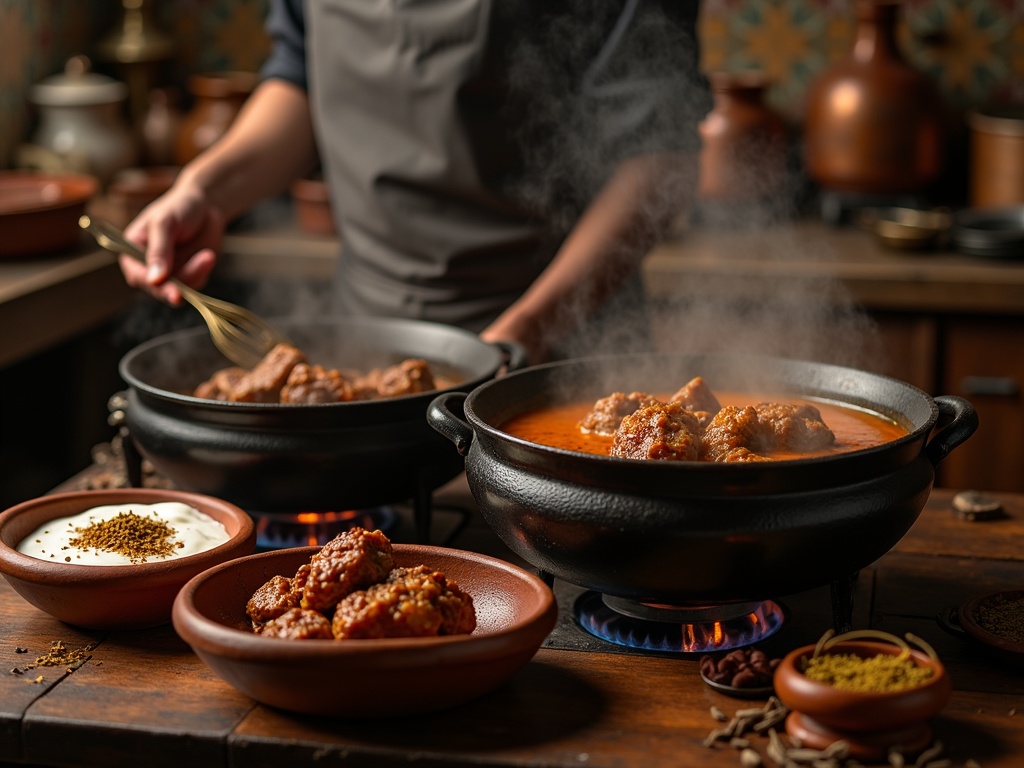
Tips For The Best Results
When cooking gosht dishes, the difference between good and great often comes down to a few key techniques. I’ve found that applying these practices consistently elevates the flavor and texture of this classic meat dish.
Preparation Techniques
Marination is crucial for developing deep flavors in gosht. I recommend marinating your meat for at least 2 hours, though overnight produces even better results. The acids and enzymes in your marinade (typically yogurt-based) help break down tough protein fibers, making the meat tender. For an authentic Indian-style meat dish, include ginger, garlic, and warm spices in your marinade.
Always use freshly ground spices when possible. Pre-ground spices lose their potency quickly, while freshly ground ones add vibrant flavor. I toast whole spices like cumin seeds, coriander, and cardamom pods in a dry pan before grinding to release their essential oils and enhance their taste profile. This small step makes a significant difference in your final dish.
Cooking Method
Patience is key when cooking gosht. I maintain a low to medium heat throughout the cooking process, which allows the meat to slowly tenderize while the flavors meld together. Rushing this process with high heat often results in tough, chewy meat and underdeveloped flavors.
Keep stirring the dish occasionally to prevent it from sticking to the bottom of your pot or pan. This is particularly important during the initial stages when the onions are caramelizing and later when the gravy is thickening. Even stirring helps distribute heat evenly and ensures consistent flavor throughout.
Before serving your hearty meat stew, allow it to rest for 10–15 minutes off the heat. This resting period helps the meat reabsorb some of the juices that have been released during cooking. The result is juicier meat and a more concentrated flavor in your finished dish.
These simple but effective techniques will transform your gosht dishes, creating rich, tender, and flavorful results that will impress anyone at your table. The combination of proper marination, slow cooking, fresh spices, and a little patience yields incredible rewards.
Serving Suggestions
The perfect gosht dish deserves equally perfect accompaniments to create a complete dining experience. Whether you’ve prepared a rich rogan josh, a spicy keema, or a delicate korma, the right serving elements can elevate your meal from delicious to memorable.
Perfect Pairings
Nothing complements the complex flavors of gosht dishes better than freshly made bread or perfectly cooked rice. I find that naan bread, with its soft, pillowy texture, is ideal for soaking up the rich gravy that accompanies most gosht preparations. The slight char from a tandoor or hot skillet adds another dimension that balances the spices in the meat. If you prefer something lighter, roti or chapati works wonderfully too.
Rice offers a different but equally satisfying pairing. Basmati rice, with its fragrant aroma and distinct grains, provides a neutral canvas that lets the flavors of your gosht shine. For special occasions, I suggest serving your gosht with flavorful biryani rice that incorporates complementary spices and vegetables, creating a meal that’s truly celebratory.
Hot gosht dishes need to be served immediately after cooking to truly appreciate their flavors. The steaming meat and aromatic gravy create an inviting atmosphere at the table that’s hard to resist. For balance, I always serve a side of cooling raita—yogurt mixed with cucumber, mint, and a touch of cumin provides the perfect temperature and flavor contrast to spicy gosht preparations.
Enhancing Presentations
The final touches can transform a simple meal into a feast for both the eyes and palate:
- Fresh herb garnishes like cilantro, mint leaves, or finely sliced green onions add color, aroma, and a fresh flavor counterpoint
- Thin slices of green chilies provide optional heat and visual appeal
- Ginger julienne adds a pop of color and zingy flavor
- Lemon wedges offer a bright, acidic note that cuts through rich flavors
- Fried onions create textural contrast and nutty sweetness
Pickled vegetables make an excellent accompaniment to gosht dishes, particularly those with tender lamb as the star ingredient. The sharp, tangy flavors of pickled carrots, onions, or even mango (achaar) provide a palate-cleansing contrast to the rich, meaty main course. I like to serve these in small bowls alongside the main dish, allowing guests to adjust the flavor combinations to their preference.
For a complete meal experience, consider adding a fresh salad of sliced onions, tomatoes, and cucumbers dressed simply with lemon juice and a sprinkle of chaat masala. This adds a crisp texture and refreshing element to balance the heartier gosht dish.
When hosting guests, I arrange the gosht in a wide, shallow serving dish that showcases the color and texture of the curry. The rice goes in a separate bowl, allowing guests to serve themselves their preferred proportion. Bread can be stacked in a cloth-lined basket to keep it warm, and all accompaniments arranged within easy reach to create an inviting, communal dining experience that honors the tradition of sharing these flavorful dishes.
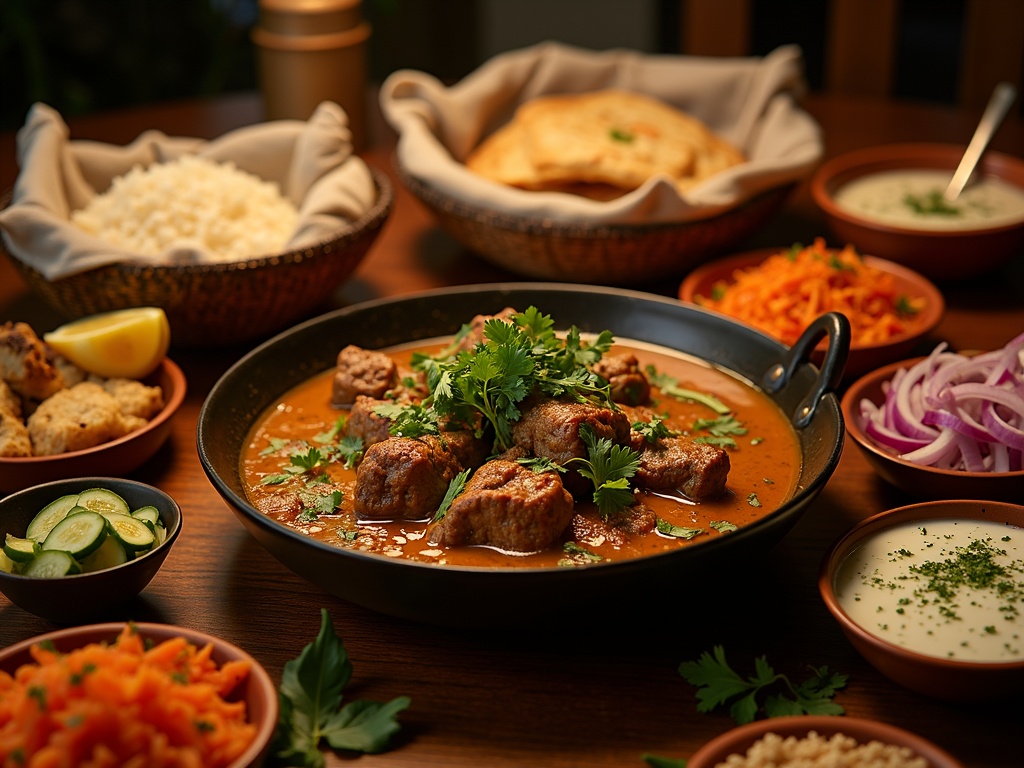
Storage And Leftovers
I’ve found that properly storing gosht dishes preserves their rich flavors and extends enjoyment beyond the initial meal. The hearty nature of gosht makes it perfect for leftovers, often tasting even better the next day as the spices have more time to meld together.
Refrigerating Gosht
For short-term storage, I always keep my gosht refrigerated in an airtight container. This meat-based dish remains fresh and safe to eat for up to 3 days when properly stored. I recommend transferring the gosht to the refrigerator within two hours of cooking to prevent bacterial growth. Using a shallow container helps cool the dish faster, which is especially important for thick, rich curry-based recipes that don’t cool quickly.
When reheating refrigerated gosht, I opt for low heat settings on the stovetop. High heat can cause the proteins to tighten and toughen, resulting in dry, chewy meat. The slow reheating process allows the flavors to bloom again without compromising the texture.
I always add a splash of water when reheating gosht dishes. This simple step:
- Prevents the sauce from reducing too much and becoming overly thick
- Protects the meat from drying out
- Helps distribute heat evenly throughout the dish
- Restores the original consistency of the gravy
Freezing for Long-Term Storage
For longer preservation, gosht freezes remarkably well and can be stored for up to 2 months without significant quality loss. I’ve discovered that lamb and mutton dishes tend to freeze particularly well compared to other meats.
To freeze gosht properly, I cool it completely before transferring to freezer-safe containers, leaving a small space at the top since the food will expand slightly when frozen. For convenience, I portion the gosht into meal-sized containers, making it easier to thaw only what I need.
For the best quality when freezing:
- Label containers with the dish name and freezing date
- Use containers designed for freezer storage to prevent freezer burn
- Allow ample space between frozen items for proper air circulation
- Keep the freezer at a consistent temperature
When it’s time to enjoy the frozen gosht, I thaw it overnight in the refrigerator rather than at room temperature. This gradual thawing preserves the texture and flavor while ensuring food safety. Once thawed, I reheat using the same low-heat method with added moisture.
I’ve noticed that certain gosht variations like those in biryani-style recipes benefit from separating the meat from the rice before freezing, then recombining them during reheating for the best texture.
The spices in gosht dishes continue to develop complex flavors during storage, which is why some people deliberately make these dishes a day in advance. When properly stored and reheated, gosht can be just as delicious—if not more so—than when freshly made.
